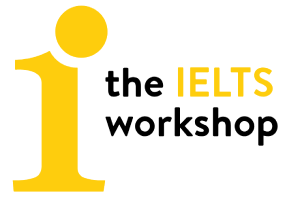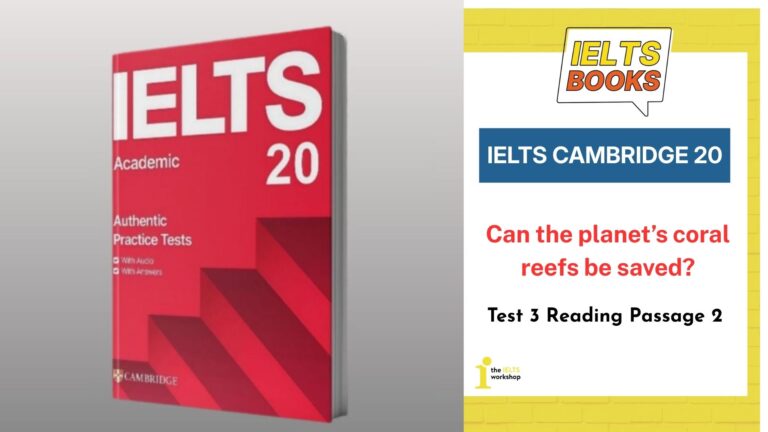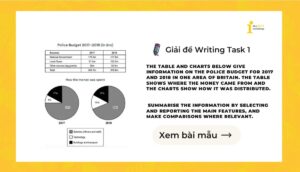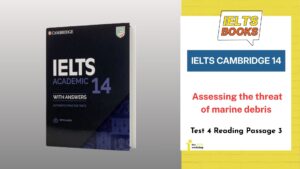Bài viết cung cấp đáp án và lời giải chi tiết IELTS Cambridge 20 Test 3 Reading Passage 2: Can the planet’s coral reefs be saved bởi đội ngũ giáo viên đạt band điểm cao tại The IELTS Workshop. Hy vọng rằng chúng mình được đồng hành cùng bạn trên hành trình chinh phục band điểm IELTS mơ ước.
Đáp án IELTS Cambridge 20 Test 3 Reading Passage 2
| Câu hỏi | Đáp án |
|---|---|
| 14. | v |
| 15. | ii |
| 16. | iv |
| 17. | vii |
| 18. | iii |
| 19. | vi |
| 20. | C/E |
| 21. | C/E |
| 22. | B/D |
| 23. | B/D |
| 24. | tentacles |
| 25. | protection |
| 26. | color/colour |
Phân tích chi tiết IELTS Cambridge 20 Test 3 Reading Passage 2
Question 14 – 19:
Câu hỏi: Write the correct number, i-vii, in boxes 14-19 on your answer sheet.
i Tried and tested solutions
ii Cooperation beneath the waves
iii Working to lessen the problems
iv Disagreement about the accuracy of a certain phrase
v Two clear educational goals
vi Promoting hope
vii A warning of further trouble ahead
(Viết số đúng, i-vii, vào ô 14-19 trên phiếu trả lời của bạn.
i Các giải pháp đã được kiểm chứng
ii Hợp tác dưới sóng gió
iii Nỗ lực giảm thiểu vấn đề
iv Bất đồng về tính chính xác của một cụm từ nào đó
v Hai mục tiêu giáo dục rõ ràng
vi Nuôi dưỡng hy vọng
vii Cảnh báo về những rắc rối sắp tới)
Question 14. v
Câu hỏi: Paragraph A
Transcript: “Coral reefs are the most diverse ecosystems on Earth and we want to show people how wonderful they are,” said Paul Pearce-Kelly … “However, we also want to highlight the research and conservation efforts that are now being carried out…”
Phân tích: Hai mục tiêu giáo dục được nêu rõ ràng: (1) giúp công chúng nhận ra sự phong phú của rạn san hô, (2) giới thiệu công tác nghiên cứu và bảo vệ. Do đó, tiêu đề phù hợp là “Two clear educational goals”.
Question 15. ii
Câu hỏi: Paragraph B
Transcript: “… polyps are transparent but get their brilliant tones … from algae … while their photosynthesising … provides nutrients for the polyps … This comfortable symbiotic relationship …”
Phân tích: Quan hệ cộng sinh giữa polyp và tảo là nội dung chính của đoạn. “Cooperation” và “symbiotic relationship” hoàn toàn tương đương về ý nghĩa.
Question 16. iv
Câu hỏi: Paragraph C
Transcript: “… coral reefs are often described as the ‘rainforests of the sea’, though the comparison is dismissed by some naturalists …”
Phân tích: Đoạn văn trình bày sự không đồng tình với một cụm so sánh phổ biến. Do đó, đáp án đúng là “Disagreement about the accuracy of a certain phrase”.
Question 17. vii
Câu hỏi: Paragraph D
Transcript: “… scientists advise that more than 90% of reefs could be lost by 2050 unless urgent action is taken…”
Phân tích: Toàn bộ đoạn là một lời cảnh báo về tương lai u ám nếu nhân loại không có hành động thiết thực – đáp án phù hợp là “A warning of further trouble ahead”.
Question 18. iii
Câu hỏi: Paragraph E
Transcript: “One aim will be to carry out research on species to find those that can survive best … Another will be to try to increase coral breeding rates.”
Phân tích: Các nhà khoa học đang chủ động tìm giải pháp giảm thiểu tác động của biến đổi khí hậu lên san hô → “Working to lessen the problems”.
Question 19. vi
Câu hỏi: Paragraph F
Transcript: “… progress … can be shown to the public and encourage them to believe that we can do something to save the planet’s reefs …”
Phân tích: Việc công khai thành quả nghiên cứu không chỉ mang tính giáo dục mà còn khơi dậy hy vọng – đúng với “Promoting hope”.
Question 20 – 21. C, E (in any order)
Câu hỏi: Which TWO of these causes of damage to coral reefs are mentioned by the writer? (Hai trong số những nguyên nhân nào sau đây được tác giả đề cập là có hại cho rạn san hô?)
Vị trí: Đoạn D.
Transcript: “… Other menaces include ocean acidification, sea level increase, pollution by humans, deoxygenation and ocean current changes, while the climate crisis is also increasing habitat destruction.”
Phân tích:
C. The contamination of the sea from waste
⇒ ĐÚNG. “Pollution by humans” chính là ô nhiễm do rác thải, chất thải sinh hoạt, hóa chất – tương đương với “contamination of the sea from waste”.
E. Alterations in the usual flow of water in the seas
⇒ ĐÚNG. “Ocean current changes” được hiểu là sự thay đổi dòng hải lưu – đúng với “alterations in the usual flow of water”.
Question 22 – 23. B, D (in any order)
Câu hỏi: Which TWO of the following statements are true of the researchers at London Zoo? (Hai trong số các phát biểu sau đây đúng với các nhà nghiên cứu tại Sở thú London?)
Vị trí: Đoạn E.
Transcript: “One aim will be to carry out research on species to find those that can survive best in warm, acidic waters. Another will be to try to increase coral breeding rates.”
Phân tích:
B. They want to identify corals that can cope well with the changed sea conditions. ⇒ ĐÚNG. Họ đang nghiên cứu các loài có khả năng sống sót trong môi trường ấm và nhiều axit – hoàn toàn trùng khớp với mô tả.
D. They are trying out methods that would speed up reproduction in some corals. ⇒ ĐÚNG. Việc nghiên cứu cách giúp san hô sinh sản nhân tạo nhiều lần trong năm là cách để tăng tốc độ sinh sản.
Question 24. tentacles
Câu hỏi: Corals have a number of __________ which they use to collect their food. (San hô có nhiều __________ để thu nhận thức ăn.)
Vị trí: Đoạn B.
Transcript: “Corals are composed of tiny animals, known as polyps, with tentacles for capturing small marine creatures in the sea water.”
Phân tích: “Tentacles” là tua – bộ phận giúp bắt mồi, đúng với chỗ cần điền sau “a number of”.
Question 25. protection
Câu hỏi: Algae gain __________ from being inside the coral. (Tảo nhận được __________ nhờ sống bên trong san hô.)
Vị trí: Đoạn B.
Transcript: “… algae that live within them, which in turn get protection, while their photosynthesising … provides nutrients for the polyps.”
Phân tích: Mối quan hệ cộng sinh là đôi bên cùng có lợi: tảo được bảo vệ (gain protection) – phù hợp hoàn hảo.
Question 26. color/colour
Câu hỏi: Increases in the warmth of the sea water can remove the __________ from coral. (Sự gia tăng nhiệt độ nước biển có thể làm mất đi __________ của san hô.)
Vị trí: Đoạn D
Transcript: “Rising ocean temperatures are triggering bleaching events that strip reefs of their colour and eventually kill them.”
Phân tích: Tăng nhiệt độ gây ra hiện tượng “bleaching” – làm mất màu sắc → đáp án là colour.
Bản dịch chi tiết IELTS Cambridge 20 Test 3 Reading Passage 2
A.
Conservationists have put the final touches to a giant artificial reef they have been assembling at the world-renowned Zoological Society of London (London Zoo). Samples of the planet’s most spectacular corals – vivid green branching coral, yellow scroll, blue ridge and many more species – have been added to the giant tank along with fish that thrive in their presence: blue tang, clownfish and many others. The reef is in the zoo’s new gallery, Tiny Giants, which is dedicated to the minuscule invertebrate creatures that sustain life across the planet. The coral reef tank and its seven-metre-wide window form the core of the exhibition.
‘Coral reefs are the most diverse ecosystems on Earth and we want to show people how wonderful they are,’ said Paul Pearce-Kelly, senior curator of invertebrates and fish at the Zoological Society of London. ‘However, we also want to highlight the research and conservation efforts that are now being carried out to try to save them from the threat of global warming.’ They want people to see what is being done to try to save these wonders.
(Các nhà bảo tồn đã hoàn thiện những công đoạn cuối cùng của một rạn san hô nhân tạo khổng lồ mà họ đã dày công lắp ráp tại Hội Động vật học Luân Đôn (London Zoo) nổi tiếng toàn cầu. Những mẫu san hô ngoạn mục nhất hành tinh – như san hô nhánh màu xanh lá rực rỡ, san hô cuộn vàng, san hô sống lưng xanh và nhiều loài khác – đã được đưa vào bể lớn, cùng với các loài cá phát triển mạnh trong môi trường đó như cá đuôi gai xanh, cá hề và nhiều loài khác. Rạn san hô này nằm trong khu trưng bày mới của sở thú mang tên Tiny Giants, nơi dành riêng cho những sinh vật không xương sống siêu nhỏ nhưng đóng vai trò duy trì sự sống trên Trái Đất. Bể san hô và cửa kính rộng bảy mét tạo thành điểm nhấn chính của toàn bộ triển lãm.
“Rạn san hô là hệ sinh thái đa dạng nhất trên Trái Đất và chúng tôi muốn cho mọi người thấy chúng tuyệt vời như thế nào,” ông Paul Pearce-Kelly, người phụ trách cấp cao về các loài không xương sống và cá tại Hội Động vật học Luân Đôn cho biết. “Tuy nhiên, chúng tôi cũng muốn nhấn mạnh những nghiên cứu và nỗ lực bảo tồn đang được thực hiện nhằm cứu lấy chúng khỏi mối đe dọa từ hiện tượng ấm lên toàn cầu.” Họ muốn công chúng thấy rõ những việc đang được làm để cứu lấy kỳ quan này.)
Từ vựng cần nhớ:
- artificial reef: rạn san hô nhân tạo
- invertebrate: động vật không xương sống
- conservation: bảo tồn
B.
Corals are composed of tiny animals, known as polyps, with tentacles for capturing small marine creatures in the sea water. These polyps are transparent but get their brilliant tones of pink, orange, blue, green, etc. from algae that live within them, which in turn get protection, while their photosynthesising of the sun’s rays provides nutrients for the polyps. This comfortable symbiotic relationship has led to the growth of coral reefs that cover 0.1% of the planet’s ocean bed while providing homes for more than 25% of marine species, including fish, molluscs, sponges and shellfish.
(San hô được cấu tạo từ những sinh vật nhỏ gọi là polyp, có xúc tu dùng để bắt sinh vật biển nhỏ trong nước. Những polyp này trong suốt, nhưng có màu sắc rực rỡ như hồng, cam, xanh dương, xanh lá nhờ tảo sống bên trong. Đổi lại, tảo được bảo vệ, còn quá trình quang hợp của chúng cung cấp dinh dưỡng cho polyp. Mối quan hệ cộng sinh này giúp san hô phát triển, tạo thành rạn bao phủ 0,1% đáy đại dương nhưng là nơi sinh sống của hơn 25% loài biển như cá, thân mềm, bọt biển và động vật có vỏ.)
Từ vựng cần nhớ:
- polyps: sinh vật nhỏ trong san hô
- tentacles: xúc tu
- symbiotic: cộng sinh
C.
As a result, coral reefs are often described as the ‘rainforests of the sea’, though the comparison is dismissed by some naturalists, including David Attenborough. ‘People say you cannot beat the rainforest,’ Attenborough has stated. ‘But that is simply not true. You go there and the first thing you think is: where are the birds? Where are the animals? They are hiding in the trees, of course. No, if you want beauty and wildlife, you want a coral reef. Put on a mask and stick your head under the water. The sight is mind-blowing.’
(Vì vậy, rạn san hô thường được gọi là “rừng mưa dưới biển”, dù một số nhà tự nhiên học, như David Attenborough, không đồng tình với so sánh này. Ông nói: “Người ta hay nói không gì sánh được rừng nhiệt đới. Nhưng điều đó không đúng. Bạn đến đó và tự hỏi: chim đâu? động vật đâu? Chúng ẩn trong cây cả. Còn nếu muốn thấy vẻ đẹp và sự sống hoang dã, hãy lặn xuống rạn san hô. Cảnh tượng đó thực sự choáng ngợp.”)
Từ vựng cần nhớ:
- dismissed: bác bỏ
- naturalists: nhà tự nhiên học
- mind-blowing: choáng ngợp, gây ấn tượng mạnh
D.
Unfortunately, these majestic sights are now under very serious threat, with the most immediate problem coming in the form of thermal stress. Rising ocean temperatures are triggering bleaching events that strip reefs of their colour and eventually kill them. And that is just the start. Other menaces include ocean acidification, sea level increase, pollution by humans, deoxygenation and ocean current changes, while the climate crisis is also increasing habitat destruction. As a result, vast areas – including massive chunks of Australia’s Great Barrier Reef – have already been destroyed, and scientists advise that more than 90% of reefs could be lost by 2050 unless urgent action is taken to tackle global heating and greenhouse gas emissions.
Pearce-Kelly says that coral reefs have to survive really harsh conditions – wave erosion and other factors. And ‘when things start to go wrong in the oceans, then corals will be the first to react. And that is exactly what we are seeing now. Coral reefs are dying and they are telling us that all is not well with our planet.’
(Đáng tiếc là những cảnh tượng tráng lệ này hiện đang bị đe dọa nghiêm trọng, với vấn đề cấp bách nhất là căng thẳng nhiệt. Nhiệt độ đại dương tăng khiến rạn san hô bị tẩy trắng, mất màu và dần chết đi. Và đó chỉ là khởi đầu. Những mối đe dọa khác gồm: axit hóa đại dương, mực nước biển dâng, ô nhiễm, thiếu oxy và biến đổi dòng hải lưu. Khủng hoảng khí hậu cũng làm tăng việc phá hủy môi trường sống. Hậu quả là nhiều khu vực rộng lớn, bao gồm một phần lớn rạn san hô Great Barrier ở Úc, đã bị hủy hoại. Các nhà khoa học cảnh báo hơn 90% rạn san hô có thể biến mất vào năm 2050 nếu không hành động khẩn cấp để đối phó với hiện tượng nóng lên toàn cầu và khí thải nhà kính.
Pearce-Kelly cho biết san hô vốn phải chịu đựng điều kiện khắc nghiệt như sóng biển xói mòn. Và “khi đại dương bắt đầu có vấn đề, san hô là loài phản ứng đầu tiên. Đó chính xác là điều đang xảy ra. San hô đang chết dần và đang cảnh báo rằng Trái Đất không ổn.”)
Từ vựng cần nhớ:
- bleaching events: hiện tượng tẩy trắng
- deoxygenation: hiện tượng thiếu oxy
- erosion: sự xói mòn
E.
However, scientists are trying to pinpoint hardy types of coral that could survive our overheated oceans, and some of this research will be carried out at London Zoo. ‘Behind our … coral reef tank we have built laboratories where scientists will be studying coral species,’ said Pearce-Kelly. One aim will be to carry out research on species to find those that can survive best in warm, acidic waters. Another will be to try to increase coral breeding rates. ‘Coral spawn just once a year,’ he added. ‘However, aquarium-based research has enabled some corals to spawn artificially, which can assist coral reef restoration efforts. And if this can be extended for all species, we could consider the launching of coral-spawning programmes several times a year. That would be a big help in restoring blighted reefs.’
(Tuy vậy, các nhà khoa học đang cố xác định những loại san hô cứng cáp có thể sống sót trong đại dương nóng lên, và một phần nghiên cứu này sẽ được thực hiện tại Sở thú London. “Phía sau bể san hô, chúng tôi đã xây phòng thí nghiệm để nghiên cứu các loài san hô,” Pearce-Kelly cho biết. Mục tiêu là tìm ra các loài có khả năng sống tốt trong môi trường nước ấm và có tính axit. Một mục tiêu khác là tăng tỉ lệ sinh sản của san hô. “San hô chỉ sinh sản một lần mỗi năm,” ông nói thêm. “Tuy nhiên, nghiên cứu trong bể cá đã giúp một số loài sinh sản nhân tạo, hỗ trợ cho việc phục hồi rạn san hô. Nếu điều này có thể mở rộng cho tất cả loài, chúng ta có thể tổ chức các chương trình sinh sản nhiều lần mỗi năm, điều này sẽ rất hữu ích cho việc phục hồi những rạn san hô bị tàn phá.”)
Từ vựng cần nhớ:
- hardy: cứng cáp, chịu được điều kiện khắc nghiệt
- spawn: đẻ trứng (đối với động vật thủy sinh như cá, san hô)
- restoration: sự khôi phục
F.
Research in these fields is being conducted in laboratories around the world, with the London Zoo centre linked to this global network. Studies carried out in one centre can then be tested in others. The resulting young coral can then be displayed in the tank in Tiny Giants. ‘The crucial point is that the progress we make in making coral better able to survive in a warming world can be shown to the public and encourage them to believe that we can do something to save the planet’s reefs,’ said Pearce-Kelly. ‘Saving our coral reefs is now a critically important ecological goal.’
(Các nghiên cứu trong lĩnh vực này đang được thực hiện tại nhiều phòng thí nghiệm trên toàn thế giới, và trung tâm ở Sở thú London cũng là một phần trong mạng lưới toàn cầu đó. Những nghiên cứu tại một nơi có thể được kiểm chứng tại nơi khác. San hô non thu được có thể được trưng bày trong bể san hô ở khu Tiny Giants. “Điều quan trọng là những tiến bộ mà chúng ta đạt được trong việc giúp san hô sống sót trong môi trường ấm lên có thể được trình bày cho công chúng và giúp họ tin rằng chúng ta có thể làm gì đó để cứu các rạn san hô của hành tinh,” Pearce-Kelly nói. “Cứu lấy rạn san hô giờ đây là một mục tiêu sinh thái cực kỳ quan trọng.”)
Từ vựng cần nhớ:
- network: mạng lưới
- crucial: quan trọng, cốt yếu
- ecological: thuộc về sinh thái
Series giải đề IELTS Cambridge 20:
- [PDF + Audio] Cambridge IELTS 20: Cập nhật mới nhất (Bản đẹp)
- Đáp án & Lời giải chi tiết Cambridge 20: Test 1 – Test 4
- Giải chi tiết Cambridge 20 Test 3 Listening Part 1:
- Giải chi tiết Cambridge 20 Test 3 Listening Part 2:
- Giải chi tiết Cambridge 20 Test 3 Listening Part 3:
- Giải chi tiết Cambridge 20 Test 3 Listening Part 4:
- Giải chi tiết IELTS Cambridge 20 Test 3 Reading Passage 1: Frozen Food
- Giải chi tiết IELTS Cambridge 20 Test 3 Reading Passage 2: Can the planet’s coral reefs be saved?
- Giải chi tiết IELTS Cambridge 20 Test 3 Reading Passage 3: Robots and us
- [PDF + Audio] Trọn bộ Cambridge Practice Tests For IELTS 1 – 20 mới nhất
Nếu bạn đang tìm kiếm một lộ trình học bài bản, phương pháp rõ ràng và sự đồng hành từ những giảng viên giàu kinh nghiệm, The IELTS Workshop chính là nơi bạn có thể tin tưởng.
Khám phá khóa học IELTS miễn phí tại Website The IELTS Workshop để được trải nghiệm phương pháp học hiện đại, lộ trình cá nhân hóa cùng đội ngũ giảng viên chuyên môn cao ngay nhé!



![[PDF + Audio] Trọn bộ Cambridge Practice Tests For IELTS 1 – 20 mới nhất](https://onthiielts.com.vn/wp-content/uploads/2020/04/cam-1-14-764x400.jpg)
![[PDF + Audio] Cambridge IELTS 20: Cập nhật mới nhất (Bản đẹp)](https://onthiielts.com.vn/wp-content/uploads/2025/07/Cambridge-IELTS-20-300x169.jpg)




